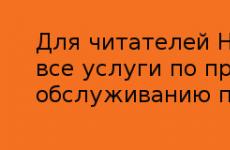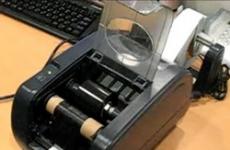Fire monitoring using satellite data. Methods for monitoring forest fires
B Monitoring fires using satellite data
I promised to post it a long time ago brief instructions... Here, I’m doing it.
General information
Operational monitoring of fires is carried out using data from 2 satellites: Aqua and Terra. Each of them is equipped with a MODIS camera that allows you to film the ground in various parts spectrum: from visible to infrared. Satellites photograph the same territory 2-4 times a day. The received information is automatically processed.
Automatic fire detection based on significant temperature differences earth's surface and the source of the fire.
Used for analysis thermal channels, and information from other satellite channels helps separate the clouds. After automatic processing, a mask is obtained of those image pixels whose temperature differs significantly from the surrounding “hot spots” or “thermal spots”. Processing time is 15-40 minutes from the moment the satellite passes. It should be remembered that the satellite time of flight is given in Greenwich Mean Time (UTS)! Moscow time= UTS+4 hours!
This method has a number of limitations. “Hot spots” include any objects that differ in temperature (for example, flares in oil fields, thermal power plants, heated roofs of large buildings). Some weak fires are not taken into account due to small temperature differences. Some of the fires that occurred during the intervals between satellite flights are also not taken into account. There are false alarms due to heavy clouds.
Nevertheless, these data can and should be used to monitor fires, especially in large areas where ground observation is not possible.
There are 3 image processing algorithms:
1. The Fire Information for Resource Management System (FIRMS) University of Maryland (USA)
2. ScanEx Fire Monitoring Service (SFMS) RTC "ScanEx"
3. "Fire" department information system remote monitoring ISDM-Rosleskhoz
Each has its own advantages and disadvantages. The FIRMS system is more sensitive, capable of detecting very weak fires, but gives a large number of false alarms. SFMS is less sensitive and, accordingly, misses some weak fires, but gives much fewer false alarms.
Usage
1. To know the approximate time of receiving data, you need to look at the flight schedule of 2 satellites.
Aqua http://www.ssec.wisc.edu/datacenter/aqu a/
Terra http://www.ssec.wisc.edu/datacenter/ter ra/
Follow the links to go to the pages, select the desired territory and date.
A page opens with a satellite flyby diagram 
The satellite films a strip along the flight path. A fragment of such a strip is indicated by a blue outline in the figure. The width of the shooting lane in each direction from the trajectory ( green arrow) is approximately equal to half the distance between adjacent trajectories (orange arrow)
Satellites fly over one territory 2-4 times a day; accordingly, information about hot spots will be updated that many times. Information on the websites will be updated 15-40 minutes after the flight.
You can view thermal points either on special websites or in the Google Earth program.
Websites. There are currently 3 main ones.
The most functional and fastest loading, in my opinion, site Kosmosnimki
Satellite monitoring forest fires
The task of promptly detecting and monitoring fires is of particular relevance due to the large territory occupied by forests. In addition to causing damage to forestry, fires have a strong impact on the ecological situation and can threaten human life.
The real scale of fires in Russian forests and the extent of damage caused by fire have not yet been established. Regular observations of forest fires are carried out only in the zone of active forest protection, covering 2/3 of the total forest area. In the northern regions of Siberia and Far East covering 1/3 of the country's forest fund, recording fires and active struggle with fire are practically absent. In the zone of active forest protection, from 15 to 30 thousand forest fires are recorded annually on an area from 0.5 to 2.5 million hectares.
Timely detection of fires and determination of their characteristics is one of the most serious tasks. The most common and traditional way to solve this problem on a regional scale is to organize air patrols of fire-hazardous areas, which requires significant material costs. Of the total actively protected area of 760 million hectares, the area served by aviation covers about 725 million hectares. At the same time, about 550 million hectares located in the taiga zone with a sparse road network are classified as areas where aviation fire extinguishing equipment is predominantly used. A sharp decline in funds allocated for forest protection in recent years, had the greatest impact on aviation forest protection. The consequence of this was a significantly increased number of forest fires going out of control and becoming natural disasters.
In this regard, there is a need to involve all available means of rapid fire detection in early stage their development, which explains the increasing role of satellite systems for remote sensing of the Earth in this. Space monitoring has a number of advantages compared to aerial reconnaissance: high efficiency, large area coverage of the earth's surface and lower operating costs. In a protected area, satellite data serves as a significant complement to traditional methods detection, and in unguarded areas - the only means of monitoring and assessing the consequences of forest fires.
Detection of fires in images of the Earth from space is possible due to the significant difference in temperature of the earth's surface (usually no higher than 10-25 degrees C) and the source of the fire (300-900 degrees C), which leads to a difference in the thermal radiation of these objects by thousands of times. This feature allows, when shooting with thermal equipment with a spatial resolution of 1 km, to detect a fire with an area of 100 m2, or a smoldering zone with an area of 900 m2. Prompt detection of fires of such an area allows timely measures to be taken to eliminate them.
Of the modern satellites for the purposes of operational fire monitoring, the most widely used satellites are the NOAA series (AVHRR radiometer with a spatial resolution of 1,100 m and a swath of 3,000 km) and EOS (Terra and Aqua satellites with a MODIS radiometer installed on them with a spatial resolution of 250, 500 , 1,000 m and a swath of 2,330 km).
Each of these satellite systems allows for operational monitoring of vast areas, receiving data at least 6 times a day (NOAA series satellites) and 4-6 times a day (EOS series satellites).
The choice of these particular satellite systems is explained, first of all, by the license-free (free) reception of images from these systems in the presence of a receiving station, as well as the appearance in lately relatively inexpensive, compared to foreign analogues, receiving stations. For example, ScanEx stations for receiving AVHRR data and EOScan and UniScan stations for receiving MODIS data from EOS series satellites, developed and supplied by ScanEx RDC.
The algorithm for automatically identifying fires is implemented in software, supplied by ScanEx RDC:
- ScanViewer (for NOAA series satellites);
- ScanEx MODIS Processor (for EOS series satellites).
It is possible to share data from NOAA and EOS satellites. This increases the efficiency of obtaining information and increases the likelihood of early detection of fires.
There are several options for the consumer to obtain snapshots of both systems:
- via the Internet in almost real time;
- receiving images from EOS series satellites via the Internet in addition to receiving data from NOAA series satellites to its own receiving station;
- reception of data from both systems at its own receiving stations.
Both sources of information, i.e. AVHRR-NOAA, and more recently also MODIS-EOS, are used for fire monitoring purposes in many countries (e.g. Brazil, Canada, Finland). In the United States, data from both systems was used during the catastrophic fires of 2000 in the states of Montana and Idaho. In Finland, a national automatic program receiving, processing and distributing messages about detected forest fires to the field.
In our country, to conduct operational space monitoring in the interests of forest fire protection services, there are reception centers deployed in many cities. Thus, a departmental network of stations of the Ministry of Natural Resources of Russia has been created with satellite data reception centers in the cities. Moscow, Yekaterinburg, Irkutsk, Yakutsk, Yuzhno-Sakhalinsk and Gelendzhik.
Satellite observation data are very important in assessing the spread of forest fires, identifying their sources, analyzing the development of smoke from fires and burns, and identifying the risk of fires.
The ability to extinguish a fire in a small area, especially in high conditions fire danger, is determined by the efficiency of detection. Thus, satellites with high radiometric resolution and high imaging frequency (NOAA and EOS series) meet the most suitable requirements for operational monitoring of forest and peat fires. To monitor the consequences of fires, it is necessary to use satellites with high spatial resolution.
Tasks fire monitoring and their consequences:
- fire detection, location of fires;
- monitoring and control of fire development;
- assessment of fire danger within the season;
- predicting fire risks in the long term;
- fire impact assessment. Combining images before and after fires makes it possible to identify burnt areas, determine their current area and assess the damage caused.
Consequences of forest fires on environment and person:
- Economic: wood loss, incl. damage to young trees and secondary forest resources; Expenses for extinguishing, clearing burnt areas, etc.; restoration work; losses of other industries: cessation of air, railway, road transportation, shipping, etc.
- Environmental: pollution by combustion products of the air, water, soil:
- destruction of oxygen;
- thermal pollution;
- mass release greenhouse gases;
- microclimate changes;
- smoke and atmospheric pollution;
- death of animals and plants;
- decline in biodiversity.
- Social: death and injury to people directly in the fire zone; deterioration of psychophysiological indicators of the population: physical, emotional, intellectual, reproductive, heredity; increase in population morbidity; decrease in life expectancy.
To detect fires, thermal channels of satellite images are used (Fig. 1, Table 1, 2.).
Table 1. Wavelength ranges.
Figure 1
| Range | Abbreviations | ||
Russian |
English |
Russian |
English |
UV |
|||
Infrared |
|||
Near IR |
|||
Medium IR |
Short Wave Infrared |
||
Far IR |
Mid Wave Infrared |
||
Thermal IR |
Thermal Infrared |
||
Microwave |
|||
Spacecraft that can detect fires are presented in table 1.
Table 2. Characteristics of the spacecraft.
SC/Device |
NOAA/ |
TERRA(AQUA)/
|
LANDSAT/ |
TERRA/ |
Visibility, km. |
||||
Radiometric resolution, bit |
NIR – 8 |
|||
Spatial resolution, m. |
NIR - 250-1000 |
NIR, SWIR – 30 TIR - 60 |
NIR – 15 |
|
Number of spectral channels in the IR range |
NIR – 1 |
NIR – 6 |
NIR – 1 |
NIR – 1 |
Fire detection methods are based on the analysis of brightness temperatures in individual spectral channels.
The key feature of the search phenomenon is a local increase in temperature at the site of the fire.
Detecting fires visually allows you to quickly and accurately determine the thresholds for detecting thermal anomalies. In general, these thresholds will be different. This is primarily due to the area and temperature of combustion, time of year and day, and geographical coordinates fire places.
The presence of a combustion source in the visible spectrum is determined by the presence of the main decoding sign of forest fires - a smoke plume.
The shape in the photo resembles a cone light gray. It should be remembered that cirrus and stratus clouds in their structure and brightness can resemble smoke plumes from forest fires. Therefore, those parts of the visible spectrum images where a forest fire was previously detected are viewed in the infrared range of the spectrum. In this case, smoke plumes from forest fires are practically invisible.
All methods are based on the following principles:
- Analysis of signal distribution within certain spectral channels of surveillance equipment;
- Threshold rule for assigning an image area (or pixel) to the corresponding class;
- Statistical analysis of the distribution of spectral characteristics of individual image areas (or pixels);
- Analysis of the reliability of assigning a registered signal to the appropriate class.
Sequence of procedures space image processing:
- Definition of information channels.
- Identification of clouds, water bodies and lost data in images in certain channels.
- Identification of potential fire locations.
- Determination of local spectral features of the surface and registration of fires using indirect signs.
- Refinement of detection taking into account local features, application of complex rules for identifying fires.
- Analysis of the possibility of erroneous recognition.
- Certification of detection results and decision making.
The algorithm for automatic detection of fires is implemented in software supplied by ScanEx RDC:
- ScanViewer(for NOAA series satellites). Specialists from ScanEx RDC have implemented a device in the ScanViewer application that allows automatic detection of forest fires using data from the AVHRR radiometer, which is part of the onboard measuring complex of the NOAA series satellite. The combination of automatic detection algorithms with visual image review and overlay of map information forms the basis of interactive forest fire detection and monitoring technology. The disadvantage of these methods is that it is only possible to accurately determine major fires.
- ScanEx MODIS Processor(for EOS series satellites). To identify and quickly detect fires, the ScanEx MODIS Processor application uses algorithms developed for the MODIS device to determine the location of fires and their intensity.
Fire detection technique
is based on a comparison of the temperatures (input signal intensities received by the MODIS radiometer) of each pixel in two infrared spectral channels, 21 channels (4 µm T4) and 31 channels (11 µm T11). This technique is implemented within the Scanex Modis Processor program with the ability to interactively configure input and output parameters.
It is believed that the higher the pixel temperature in channel 21, the greater the likelihood of a fire. Likewise, the greater the temperature difference in the channels is 4 µm. and 11 microns. (dT411), the greater the risk of fire.
A potential fire source is identified in two ways:
- The absolute values of each of the above quantities in a pixel (T4 and dT411) exceed permissible limits, specified in the fire mask parameters (for example, T4 above 360K during the day or dT411 above 25 K during the day).
- The value of the signal intensity in the 4 µm channel of a certain pixel is very different from the surroundings (for example, T4 > T4b + pT4.s.d.c.*dT4b - the temperature of the current pixel under study in the 4 µm channel is greater than the average temperature of the surrounding pixels + the standard deviation of the temperature of the surrounding pixels multiplied by an empirical coefficient (standard deviation coefficient, usually pT4.s.d.c = 3)).
The program has a set of parameters that determine whether a particular pixel will be registered as a fire source or not. The combination of these parameters (fire masks) significantly depends on the region. For example, the forest-steppe territory of the Kurgan region and the Ivdel taiga have different spectral reflection characteristics in the thermal range received by the MODIS radiometer. In addition, the combination of these parameters depends on the season (winter, spring, summer, autumn) and even on the time of administration.
- Software module "Fire detection" to the ERDAS Imagine application package with criteria (Table 3.).
Table 3.Criteria for detecting a thermal anomaly.
where T3p, T34p, T4p are temperature thresholds, I2, I1 are the radiation intensity in channels 1 and 2.
Temperature thresholds are set by the operator in the following intervals: T3p - 310-322 K; T34r - 7-15 K; T4p - 275-285 K. By default, the following temperature thresholds are set for summer time: T3 = 312 K; T34 = 15 K; T4 = 276 K.
MODIS (Moderate Resolution Imaging Spectroradiometer) radiometer ( Table 4.) is one of the key imaging instruments installed on board the American satellites TERRA (in orbit since 1999) and AQUA (in orbit since 2002), which study the Earth from space under the EOS (Earth Observing System) program of the National Aerospace Agency (NASA) ) USA.
Table 4.Basic technical specifications MODIS.
Channel numbers |
Spectral range(µm.) |
Sight width (km.) |
Filming period |
Spatial resolution (m.) |
||
Visible (red) |
||||||
NIR (near infrared) |
||||||
Visible (blue) |
||||||
Visible (green) |
||||||
NIR (near infrared) |
||||||
MIR (mid infrared) |
||||||
Visible (blue) |
||||||
Visible (green) |
||||||
Visible (red) |
||||||
NIR (near infrared) |
||||||
TIR (thermal infrared) |
||||||
The MODIS radiometer allows for daily operational monitoring of territories, while the frequency of observation depends on its size and geographical location, as well as the number of satellites used.
The frequency of observation of a separate territory when photographed by one satellite ranges from 1-2 times per daytime and the same number of times at night. When photographed by two satellites, the frequency of observations will double - from 4 to 12 times a day (depending on the geographical location of the territory).
For the practical use of MODIS data, algorithms for processing primary radiometer data have been developed and are regularly improved; there are 44 standard information products (modules - MOD).
To detect thermal anomalies and fires, a module is used ( MOD14). It allows for rapid detection and monitoring of natural (forest) fires, volcanoes and other thermal anomalies with a resolution of 1 km. MODIS can detect a fire in an area of less than 1 km2.
Fire detection algorithms in automatic mode are based on a significant difference in temperature between the earth’s surface (usually no higher than 10–25 C) and the fire site (300–900 C). An almost 100-fold difference in the thermal emission of objects is captured in the image, and information coming from other spectral channels helps separate the clouds.
Surveying with thermal equipment of the MODIS spectroradiometer with a spatial resolution of 1 km makes it possible to identify a fire source with an area of 1 hectare or underground fire area from 9 hectares.
The NOAA series satellites are equipped with two sets of instruments: AVHRR (Advanced Very High Resolution Radiometer) (Table 5.) and a set of equipment for vertical sounding of the atmosphere.
Space imaging by NOAA satellites makes it possible to track fires mainly on a regional scale through the low spatial resolution of the images (1.1 km).
Table 5. Main technical characteristics of AVHRR.
Channel numbers |
Spectral range(µm) |
Sight width (km.) |
Filming period |
Radiometric resolution (bits) |
.) |
|
Visible (green) |
||||||
NIR (near infrared) |
||||||
3 A |
NIR (near infrared) |
|||||
3 B |
NIR (near infrared) |
|||||
TIR (thermal infrared) |
||||||
TIR (thermal infrared) |
||||||
To identify fires using a “threshold” or “contextual” algorithm, at the preliminary stage, all information received from NOAA satellites must be calibrated. This means that for the first and second channels of the AVHRR equipment it is necessary to obtain the albedo values A1, A2, respectively. And for the third, fourth and fifth channels - the values of the equivalent radiation temperature T3, T4 and T5, respectively.
Fire detection methods is based on the use of radiation assessment for 3B, 4, 5 AVHRR channels, which correspond to the infrared range of the spectrum. fires are defined as extreme values of radiation along the 3B channel (the maximum radiation of objects at a combustion temperature of 800-1000K falls in this area) AVHRR.
Smoke plumes caused by fires are well identified on AVHRR channels 1 and 2.
To more accurately identify fires, threshold algorithms are used, beyond which the radiation temperature is determined via the 3rd and 4th channels. The AVHRR device is calibrated for temperatures up to 330 K.
It is known that the maximum radiation flux of a black body heated to a temperature of 800-1000 K falls in the mid-infrared region of the electromagnetic spectrum with a wavelength of 3-4 microns. Based on the characteristics of the AVHRR equipment, data from the third channel operating in the range of 3.55-3.93 µm is taken as the main feature for recognizing a thermal anomaly.
Since the spatial resolution of the AVHRR equipment is 1.1 km, ideally it is possible to detect objects whose linear dimensions exceed 1.1 km. And thanks to the high radiation intensity in the mid-IR range and the high radiometric resolution of the equipment, it becomes possible to detect thermal anomalies in natural and technogenic nature many smaller sizes. IN ideal conditions observation at maximum contrast with the 3rd and 4th channels of AVHRR equipment is a principle. possibility of detecting fires with an area of 0.2-0.3 hectares.
Using only one third channel (one threshold) in the threshold algorithm leads to a large number of false alarms. This is primarily due to the reflection of solar radiation energy by the edges of clouds (the largest number of false alarms), water surfaces, sand, exposed rocks, asphalt pavements and concrete structures. To avoid errors, it is necessary to use data from other spectral channels.
Threshold algorithms for identifying fires:
- Kaufman algorithm (1991): T3 > 316 K, T3-T4 > 10 K and T4 > 250 K. Here T3, T4, T5 are the radio brightness temperature in the 3rd, 4th and 5th channels of the AVHRR equipment, respectively.
- France algorithm (1993): T3 > 320 K, T3-T4 > 15 K, 0< (T4-T5) < 5 К, A1 < 9%, где А1 - значение альбедо в 1 -м канале.
- Kennedy algorithm (1994): T3 > 320 K, T3-T4 > 15 K, A2< 16%, где А2- значение альбедо во 2-м канале.
If the permit element satisfies the conditions of the algorithm, then it belongs to the class of fires; if it does not satisfy at least one of these conditions, then it goes to the background.
All these algorithms are focused on fires of a sufficiently large area and intensity, which is unacceptable for solving problems of identifying a fire situation, since it is important to detect fires at the initial stage of their development in order to minimize the material costs of eliminating the fire. In addition, it is highly undesirable to use these algorithms to detect the presence of overheated peat in peatlands.
Today, the center for receiving and analyzing aerospace information of the Ministry of Emergency Situations of Russia has adopted Kaufman algorithm (1) with "floating" thresholds. As mentioned earlier, at the stage of preliminary processing of information from AVHRR equipment, obvious foci are determined natural fires by the presence of smoke plumes.
After image calibration, the characteristics of the identified lesions and the adjacent background are determined, on the basis of which the corresponding thresholds are selected. After analysis similar characteristics the underlying surface within the image, together with the characteristics of fires, are determined "floating" thresholds.
However, one should not completely trust the results of identifying fires using these thresholds, since there may be cases of reflection of electromagnetic energy from the edges of clouds, and false alarms may occur caused by overheated sand and various man-made formations. Therefore, questionable points that are too close to clouds, near rivers, seas, etc. must be subjected to additional verification.
An additional check consists of analyzing the reflectivity of the pixels of interest to us in the first and second channels of the AVHRR equipment. If the albedo value in the first channel is greater than the albedo value in the second channel ( A1 > A2), then this point in the vast majority of cases can be unambiguously attributed to a false alarm. but there may be cases when doubts arise about the correctness of such a decision (for example, lack of clouds or sand). In this case, we classify a given point as a possible fire source if there is no additional information about the area in question. If the albedo values in the first and second channels exceed 10-16% (depending on observation conditions), then given point also classified as a false alarm. In all other cases, the hypothesis about the presence of a thermal anomaly at the points under consideration is accepted.
If the number of false alarms is large enough, then you can slightly increase the threshold on the third and/or fourth channel. In this way, it is not possible to completely get rid of false alarms and most of the suspected outbreaks still have to be checked. In addition, we deliberately exclude small-area fires from consideration, which is also unacceptable.
Cloudiness is an opaque environment for IR radiation, so for pixels where its size occupies more than 60-70% of the image, it is automatically highlighted. Since cloudiness is colder than the earth's surface, it is possible to set a brightness temperature threshold in the 4th or 5th channel of the radiometer with masking of image pixels that do not exceed the specified threshold value.
It is proposed to take the SHARP-2 standard of the European Space Agency as a basic cloud extraction algorithm for AVHRR data. This standard provides a classification that divides image pixels into the following classes: earth surface (ES), water, clouds.
Cloudiness in the original image is highlighted according to the conditions from the ESA SHARP-2 standard:
- "Cloudy" if A(2)/A(1) > 0.9 & A(2)/A(1)< 1,1&T4 < 294 К
- "Cloudy" if T4< 249 К
- "Cloudy" if T4-T2 > 274 K & T4< 290 К
The authors made the assumption that these conditions are poorly suited for determining the cloud/solid boundary and for identifying “broken clouds” on the territory of the European part of Russia, so they proposed to introduce an additional condition. This condition is the analysis of the brightness characteristics of the 4-spectral range.
The analysis uses an additional condition (4), in which the standard deviation (4) of the equivalent radiation temperature in the 4-spectral range of the AVHRR device, calculated over a 15x15 pixel window, is analyzed:
σ4≤σpor,
where σpore is the threshold equivalent radiation temperature in the 4-spectral range of the AVHRR device over a window of 15x15 pixels, the value of which is determined as a result of the study.
According to the results of processing test images for the European part of Russia (48-67 northern latitude), σpore = 1.3.
Since in the spectral ranges of the 4th and 5th channels of the AVHRR/2 instruments (3) the influence of the Sun on the image characteristics is minimal, cloud screening can be carried out by analyzing the standard deviation of the brightness characteristic. In this case, the modified contextual algorithm takes into account not only the standard deviation value of the pixel brightness characteristics, but also the conditions of the SHARP-2 standard for AVHRR data.
For testing and consideration in the modified contextual algorithm, classification conditions from the SHARP-2 standard are selected, which were taken as basic conditions. For testing, a model for highlighting the water surface was written. For the analyzed image X(x1,..., x5), the pixels are classified according to the following criteria: “water”, “cloudiness”, “earth surface”. As a result of classification taking into account the conditions, two intermediate layers are created from the original image into the water surface and various clouds. The first, consisting of 0 and 1, where 0 corresponds to a pixel that was classified as noise and 1 corresponds to a pixel that was classified as ground. The second one, consisting of 0 and T3, where 0 corresponds to the pixel that was classified as noise and T3 corresponds to the radiation temperature in the 3rd AVHRR channel for the pixel that was classified as ground.
All pixels classified as “water” and “cloudy” are not considered in further “signal presence” analysis.
Sequentially, for each pixel, a central local area with dimensions of 15x15 pixels is allocated. For this region, 5-channel pixel characteristics are considered. The number of pixels other than the “water” and “cloudy” classes is also calculated, and the average T3av value is calculated for them.
A sign of signal isolation is the condition: T3av > T3av.port. When this condition is met, a decision is made about the “presence of a pixel with a fire.”
The use of a modified contextual algorithm makes it possible to reduce the probability of a “false alarm” by 10-15% for the territory of the Northern and Central parts of Russia. A natural advantage of this algorithm is its relative performance and independence from the angle of the Sun and time of day. The biggest drawback is the inability of the contextual algorithm in the case of cloudiness in the texture areas of the image.
Visible (green)
Visible (red)
NIR (near infrared)
NIR (near infrared)
TIR (thermal infrared)
MWIR (far infrared)
Table 8. Main technical characteristics of the ETM+ radiometer (Landsat 7).
Channel numbers |
Spectral range |
Sight width (km) |
Filming period |
Radiometric resolution (bits) |
Spatial resolution |
|
Visible (blue) |
||||||
Visible (green) |
||||||
Visible (red) |
||||||
NIR (near infrared) |
||||||
NIR (near infrared) |
||||||
TIR (thermal infrared) |
||||||
MWIR (far infrared) |
||||||
Calculation underlying surface temperature described in the article -
.
ASTER (Advanced Spaceborne Thermal Emission and Reflection Radiometer) ( Table 9) The Advanced Spaceborne Thermal Emission and Reflection Radiometer is one of five imaging systems on board the Terra satellite, combining broad spectral coverage and high spatial resolution in the visible, near-infrared (NIR), mid-infrared (MIR), and thermal infrared ranges.
Table 9.Basic technical characteristics of ASTER.
Channel numbers |
Spectral range(µm) |
Sight width (km.) |
Filming period |
Radiometric resolution (bits) |
Spatial resolution (m.) |
|
VNIR (visible and near infrared) |
||||||
3 n |
||||||
3 b( stereo) |
||||||
SWIR (mid-infrared) |
||||||
TIR (thermal infrared) |
||||||
Absolute radiometric accuracy in spectral zones is 4% for the visible and near-infrared range, and 1-3 K for the thermal range, depending on temperature. Thermal range zones are designed to record the temperature of the earth's surface.
Level-2 products:AST09T Surface radiance-TIR – Earth's surface temperature.
Table 10.Visual interpretation of space images.
KA/ |
NOAA/ |
TERRA(AQUA)/
|
LANDSAT/ |
|||
Decipher- |
General view fires with smoke plumes |
Heated areas of the earth's surface are deciphered by a white tone. |
General view of fires with smoke plumes |
The lesions are clearly visible open flame |
Surface areas with high temperature have a bright pink color. |
|
Comb- |
RGB - 6:5:7, 6:5:4 |
|||||
Space |
1, 2, 1 - 1100 m. |
1 – 250 m. |
31, 23, 21 - 1000 m. |
3, 2, 1 - 30 m. |
||
Note |
Natural |
Natural |
Far infrared |
Natural |
Middle and near |
Thermal, mid and near infrared |
List of sources
- Remote geothermal mapping.
- MODIS radiometer.
- Dubrovsky V., Parkhisenko Ya.V. Space monitoring of forest fires based on NOAA images at ULRMC.
- Identification of forest and steppe fires, methods for solving thematic problems.
- Technology for monitoring forest (peat) fires based on satellite imagery data.
- Hardware and software systems for receiving and processing remote sensing data.
- Convergence of the latest information technologies and methods of remote sensing of the earth for the construction of aerospace environmental monitoring megacities.
- Monitoring of forest and peat fires. RTC ScanEx.
- Poshlyakova L.P. Methodology for creating a GIS project based on Earth remote sensing data in order to assess the fire hazard of the territory.






